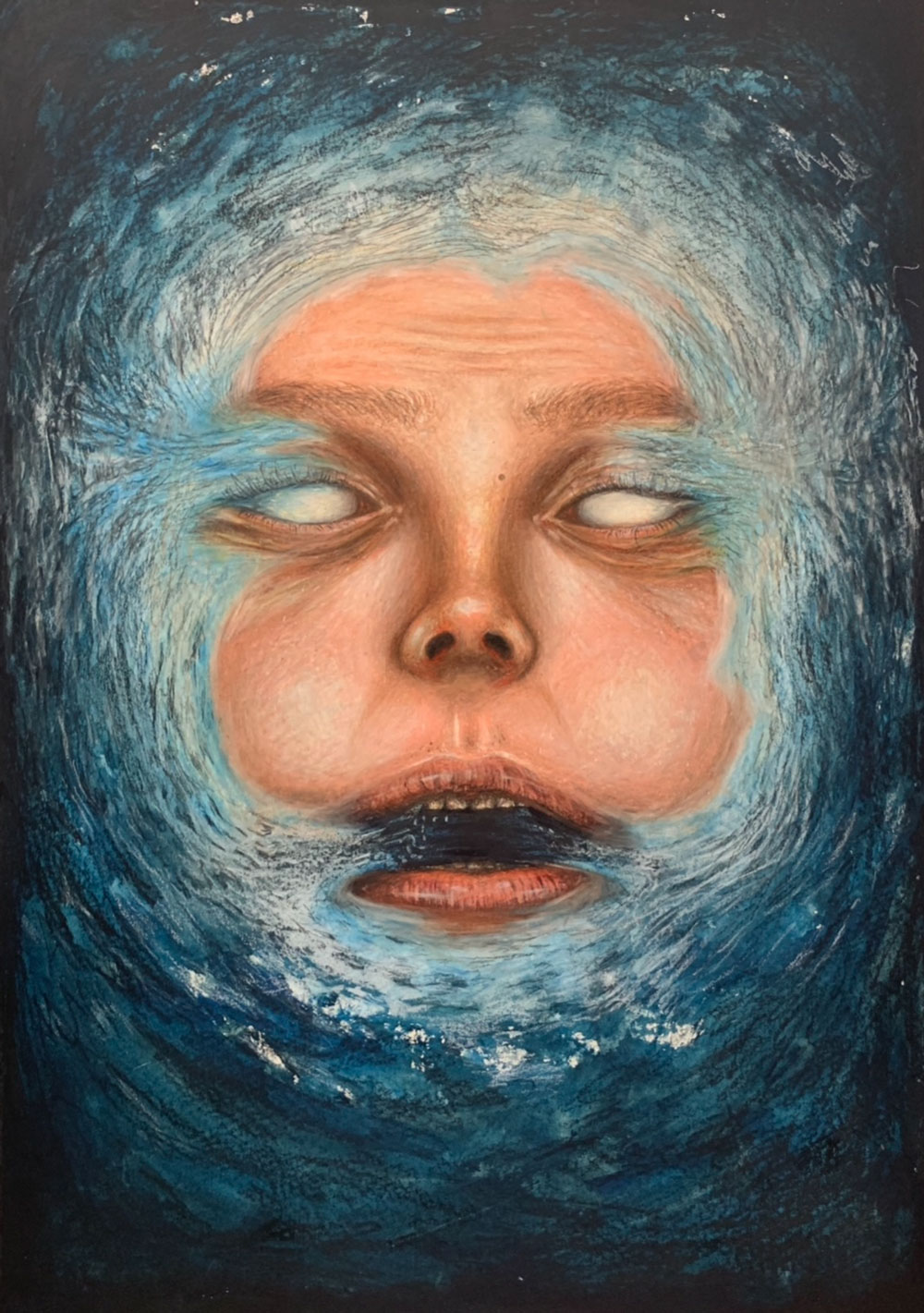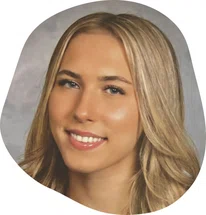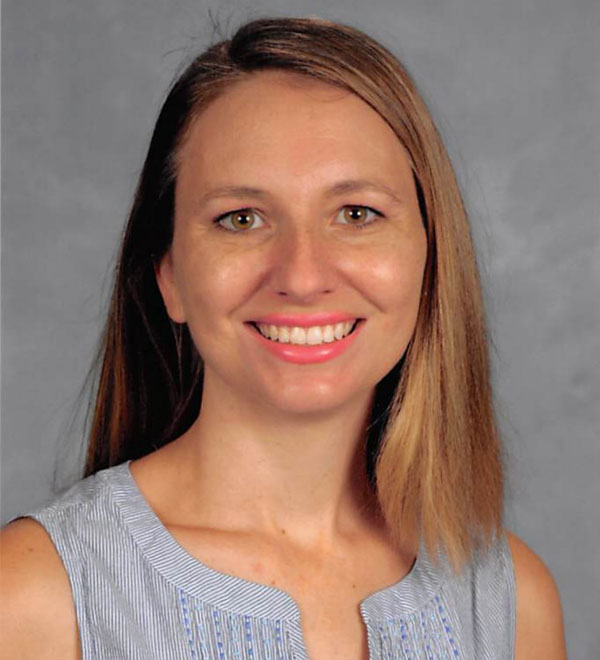


Lifeless Currents
Height: 16" x Width: 12 ' | Material(s): Watercolors, Prismacolors colored pencils | Process(es): I used a mirror to imitate facial expressions as I sketched the proportions and used harsh colors. | Citation(s): Used my own reflection | Idea(s): This photo represents the overwhelming feelings of emptiness and being engulfed in emotion. | Curatorial Note: This artwork is very expressive and successfully communicates the idea of being inundated and overwhelmed with emotions.
Gaia Kaye
Student statement
Student statement


AP DRAWING
Buchholz High School
Gainesville, FL, USA
Does your work reference or draw on a contemporary or historical artmaking style, practice, or tradition? If so, please explain.
My work references contemporary realism. The figurative but realistic style showcases meticulous detail alongside subjective, figurative themes. The style commonly uses modern themes of social issues and, in contrast to historical realism, contemporary realism dives deeper into more complex subjects. I chose to combine the use of personal narrative and high precision. I was able to do this by having it figuratively represent being overwhelmed by emotion while focusing on realism while drawing.
Please describe the context for how the idea for this artwork originated (was this part of your sustained investigation, an independent project, a class assignment, created during a summer study, etc.).
For my investigation I settled on the question, how do issues with self-perception affect you emotionally, physically, and spiritually? As I came up with ideas for pieces, I sifted through all of my old work to see if anything resonated with the investigation I chose. Eventually, I settled on the concepts demonstrated in "Lifeless Currents”—a piece made almost two years before—and felt an immediate connection. My freshman year, an assignment was given to figuratively draw the meaning behind our choice of song lyrics. I chose the song "I was all over her" by Salvia Palth. This song showcases the severity of what being overwhelmed by emotion can do. Using the distressed expression, weathered appearance, and uncomfortable situation, I aimed to portray a similar feeling.

My sustained investigation was, how does self-perception affect people emotionally, physically, and spiritually? I displayed not only obvious signs, but also the hidden, miniscule details of what an eating disorder and body image issues create.
How did you demonstrate revision in your sustained investigation?
I believe revision was the cornerstone of my portfolio. From start to finish, I continuously refined every aspect by adjusting piece sizes and materials, and even altering my sustained investigation midway through the year. By broadening the scope of my investigation, I was able to unlock new creative possibilities and significantly elevate the overall quality of my portfolio.
How did your materials and process(es) choices shape the creation or meaning of your artwork(s)?
At first, I had no clear direction with the process of this piece—just sketching aimlessly without reference, hoping to capture the emotion I envisioned. But soon, I realized something was missing—not just small details, but depth. So, I grabbed my phone, made some ridiculous faces into the camera, and tried to mimic the expressions I saw. As I added every wrinkle, crease, and mark, the drawing finally came to life. It wasn’t just a picture anymore—it had soul. That moment taught me a powerful lesson: Personality isn’t just an addition to art; it’s what gives it true meaning.
What is your advice to other AP Art and Design students?
My advice is to experiment with everything. The reason I was able to create a portfolio that truly satisfied both myself and the judges was by putting every idea I had onto paper. My notebook was filled with countless sketches—some discarded, others evolving into completed pieces. Whether it's the concept, materials, or execution, never fear mistakes or failure. Revision is key to developing a strong, well-rounded portfolio.

Lindsey Lugrin
Art Teacher
Buchholz High SchoolBuchholz High School, Gainesville, FL, USA
Teacher Statement
Teacher Statement
How did you scaffold writing into the artmaking and thinking processes?
For over a decade, I have worked with art students while they are developing their AP Studio Art portfolios. I find the most critical aspect is guiding students in creating artwork and writing that reflects their unique, personal vision. I strive to help students throughout the year to create work that is personal and meaningful to them. We initially plan and brainstorm a wide range of concepts before they select a Topic of Inquiry that truly resonates with them individually. Having worked for years with students who are exceptional artists, I find that many have difficulty in articulating their artistic choices. I employ multiple means of expression, putting students at ease to informally refine their writing and thinking processes. Primarily, I break writing tasks into smaller prompts, provide written feedback from peers and myself following class critiques, and take notes during individual conferences.
How did you structure practice, experimentation, and revision into your AP Art and Design curriculum?
While producing work, I work with students to hone their completed work and refine their concept to center upon the most succinct vision for their work. Individual conferences and critiques provide students with feedback about the meaning others derive from their art. Often, students will revise subsequent pieces based on feedback from critiques. As we approach the College Board submission deadline, I encourage students to rework 1-2 pieces made earlier in the year. Based on the skills and mental winnowing that occurs when producing multiple pieces for their sustained investigation, most students experiment with composition, mark making, or media selection on their final pieces and are happier with the finished product.
What creative programming (i.e., exhibit spaces, mentoring programs, curricular supports) have you implemented to support AP Art and Design students?
The Buchholz Art Department has a rich tradition in our annual Spring Art Show. While students of all class levels and media have work in group displays, AP Art and Design students have a unique opportunity to display their portfolio work in a personal showcase. AP students sit alongside their work and are available to answer questions as people view their art. The Spring Art Show occurs during the school day, allowing teachers and students to visit the exhibit. Parents, school board members, and other community stakeholders come to Buchholz for the event. Judges select exemplary work in a variety of categories and prizes are awarded.
What did you learn from working with your student?
As an educator, I feel it is important to allow students to explore artwork about difficult topics and experiences, but I would never suggest or expect students to delve into topics that are painful to revisit. Choosing to create artwork that documents and reflects personal struggle should always be a student’s choice. Gaia chose to create beautiful, emotional artwork about some of the darkest and most challenging chapters in her life. Her work was consistently engaging, relatable, evocative, and mature. Gaia’s written evidence states her desire to: “Display not only obvious signs but also the hidden miniscule details.” The choice to include both overt and subtle drew curious viewers. Gaia’s classmates were always in awe of her work; beautifully rendered images sometimes hinting and other times screaming depictions of isolation, hopelessness, fear, loss of control and sense of self. It was a joy working with Gaia as she created work for her AP Art Portfolio. While she had an assured vision, she was open to suggestions and feedback. I am proud not only of the finished portfolio but the artistic endeavor, vulnerability, strength, and tenacity she sustained throughout the year in pursuit of this phenomenal portfolio. Working with Gaia undoubtedly made me a stronger teacher.

Kevin L. Purvis
Buchholz High School, Gainesville, FL, USA
Principal
Leader Statement
Leader Statement
What are you most proud of regarding your school’s AP Art and Design program, student, and teacher?
I am incredibly proud of our AP Art and Design program because it fosters a vibrant community of creativity and dedication. Our students, especially Gaia, consistently impress with their talent, originality, and willingness to push artistic boundaries, creating works that not only showcase their skills but also tell compelling stories. This success is made possible by our passionate and inspiring teacher, Mrs. Lugrin, who nurtures their growth, encourages their individuality, and challenges them to excel. Together, they have built a program that reflects the power of art to inspire, connect, and transform.
What do you do to support visual arts programming in your school?
I wholeheartedly support visual arts programs at Buchholz High School because they provide students with an essential outlet for creativity, self-expression, and critical thinking. These programs cultivate unique perspectives, nurture artistic talent, and foster a sense of confidence and accomplishment in our students. Beyond the creation of art, they teach valuable life skills such as perseverance, collaboration, and problem-solving. By investing in our visual arts programs, we are empowering our students to dream big, think boldly, and contribute meaningfully to the world around them.
What is your advice to other school leaders on how to support an AP Art and Design program?
School leaders can support an AP Art and Design program by fostering a culture that values and prioritizes the arts as an essential component of a well-rounded education. This includes providing adequate funding for quality materials, dedicated studio spaces, and professional development for teachers. Leaders can also celebrate student achievements by showcasing their work through exhibitions, competitions, and community events, emphasizing the importance of artistic endeavors. By championing the program, school leaders empower students to explore their creativity and achieve academic and personal success.

Gaia Kaye
